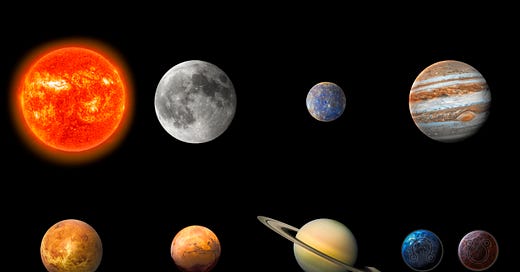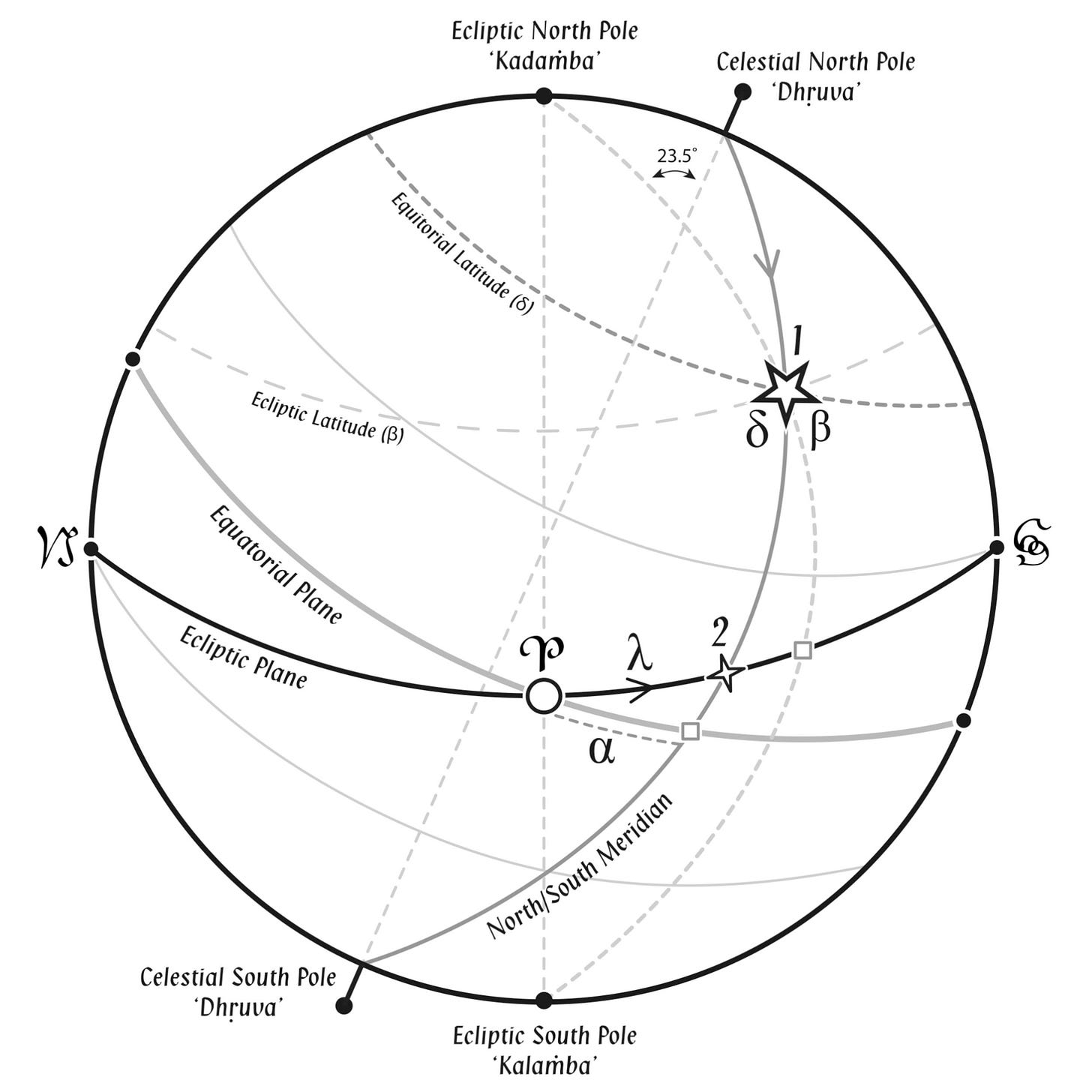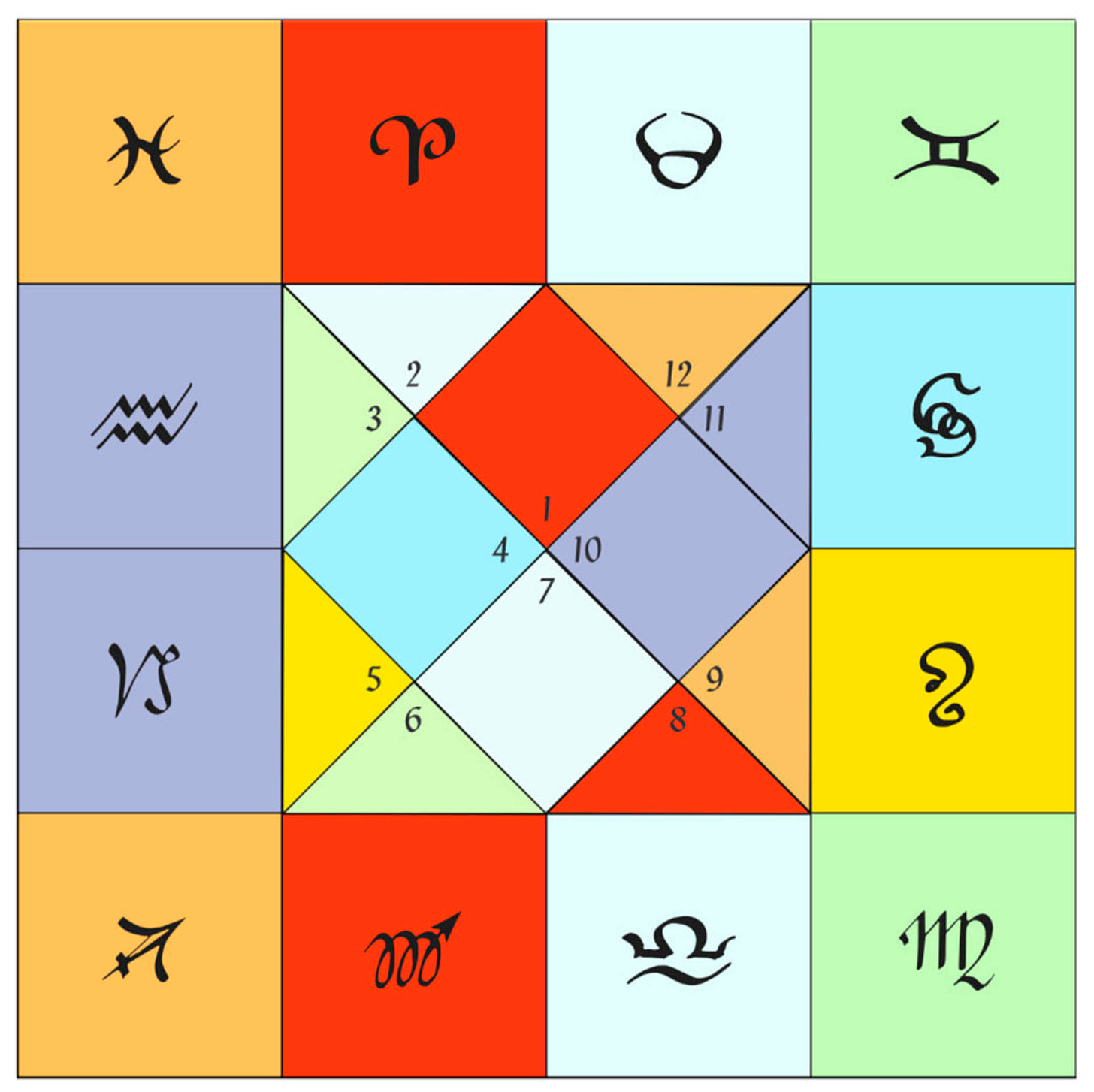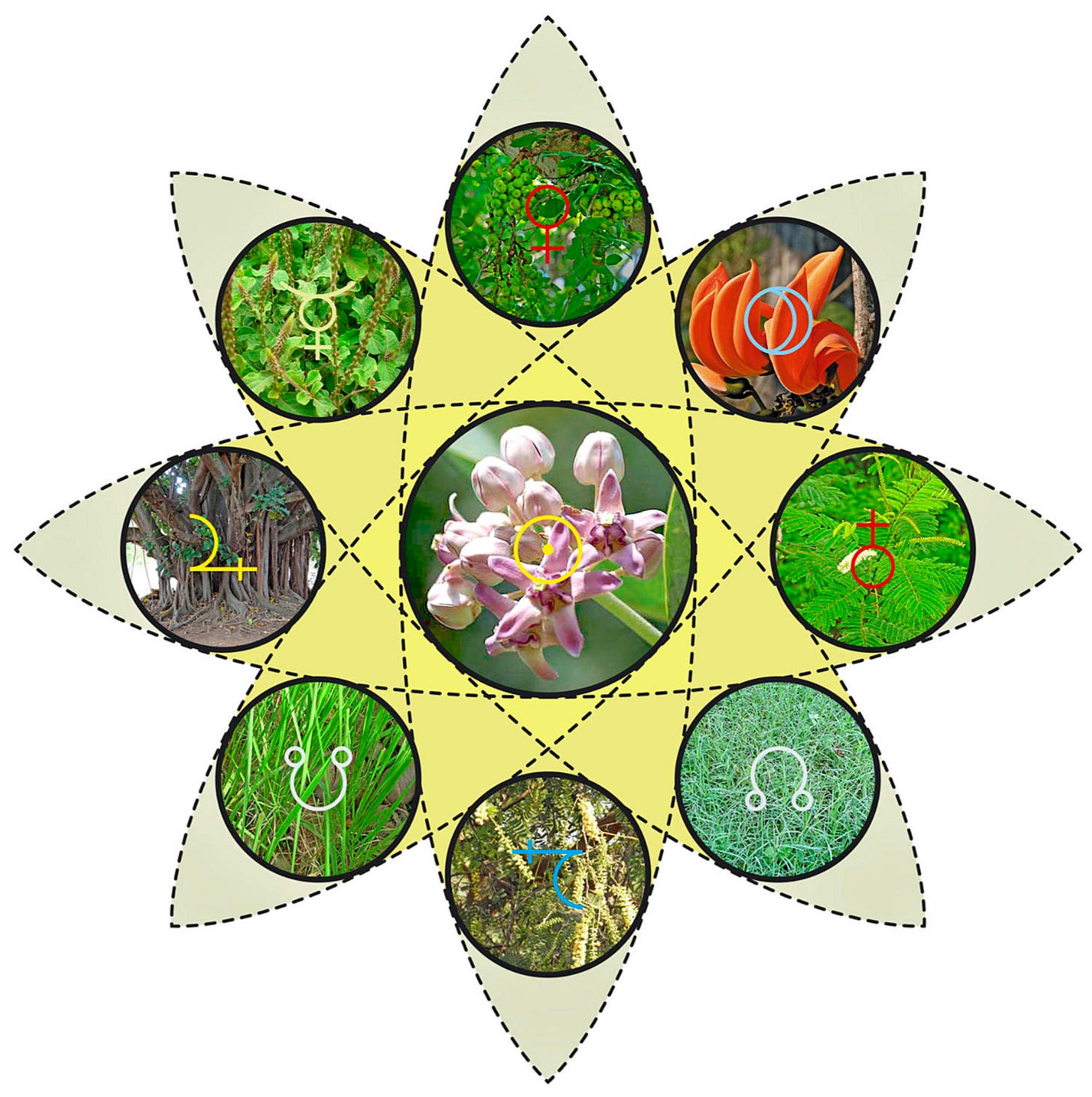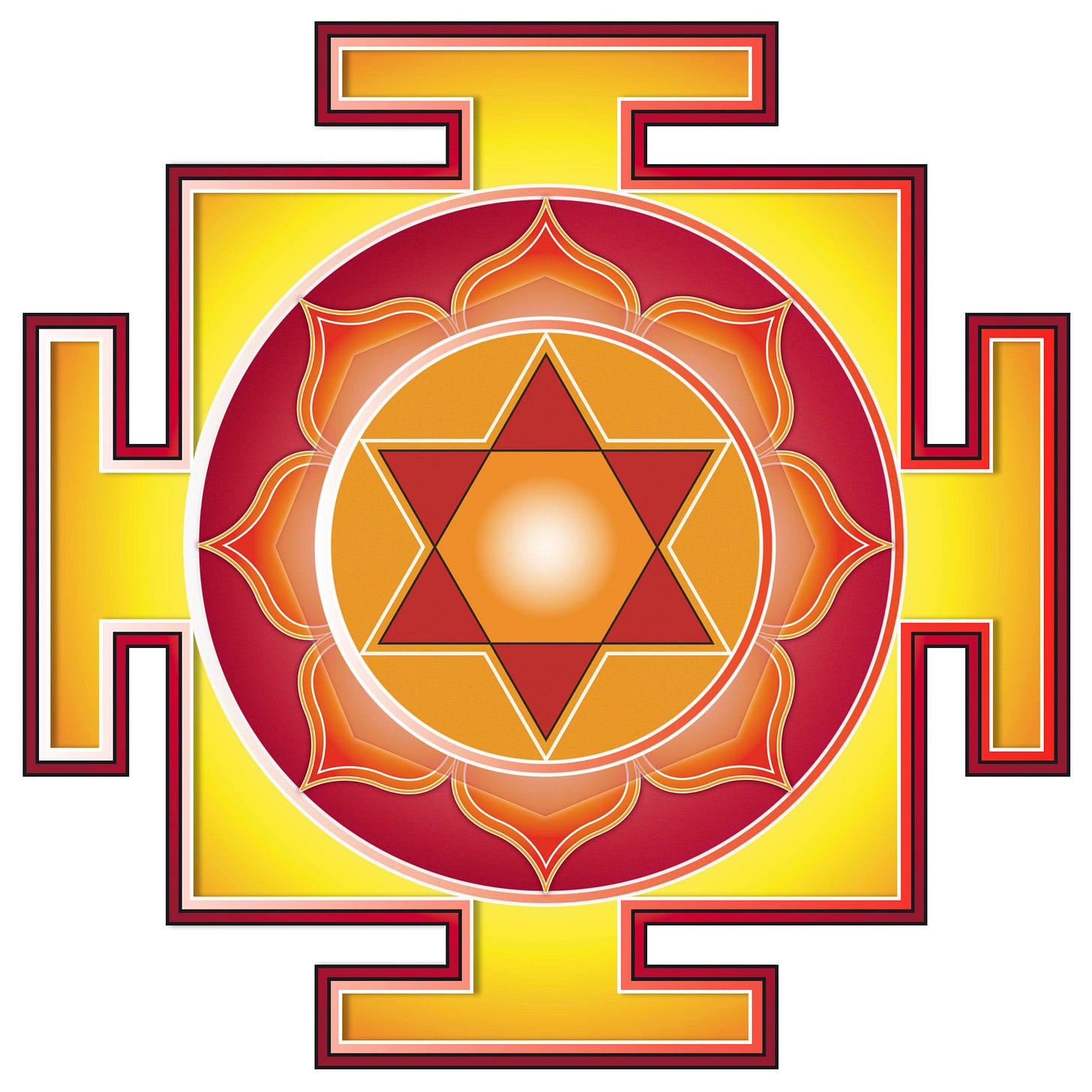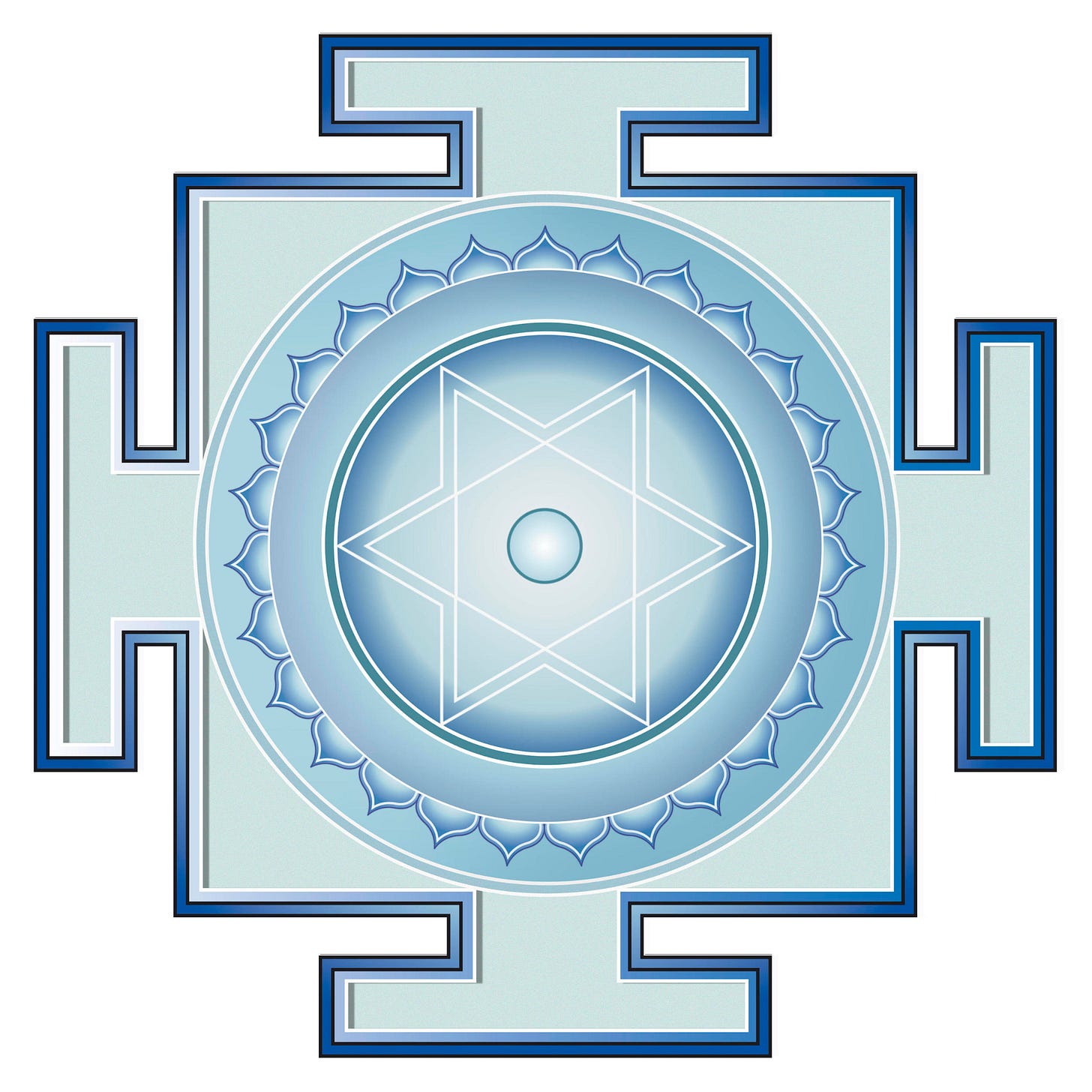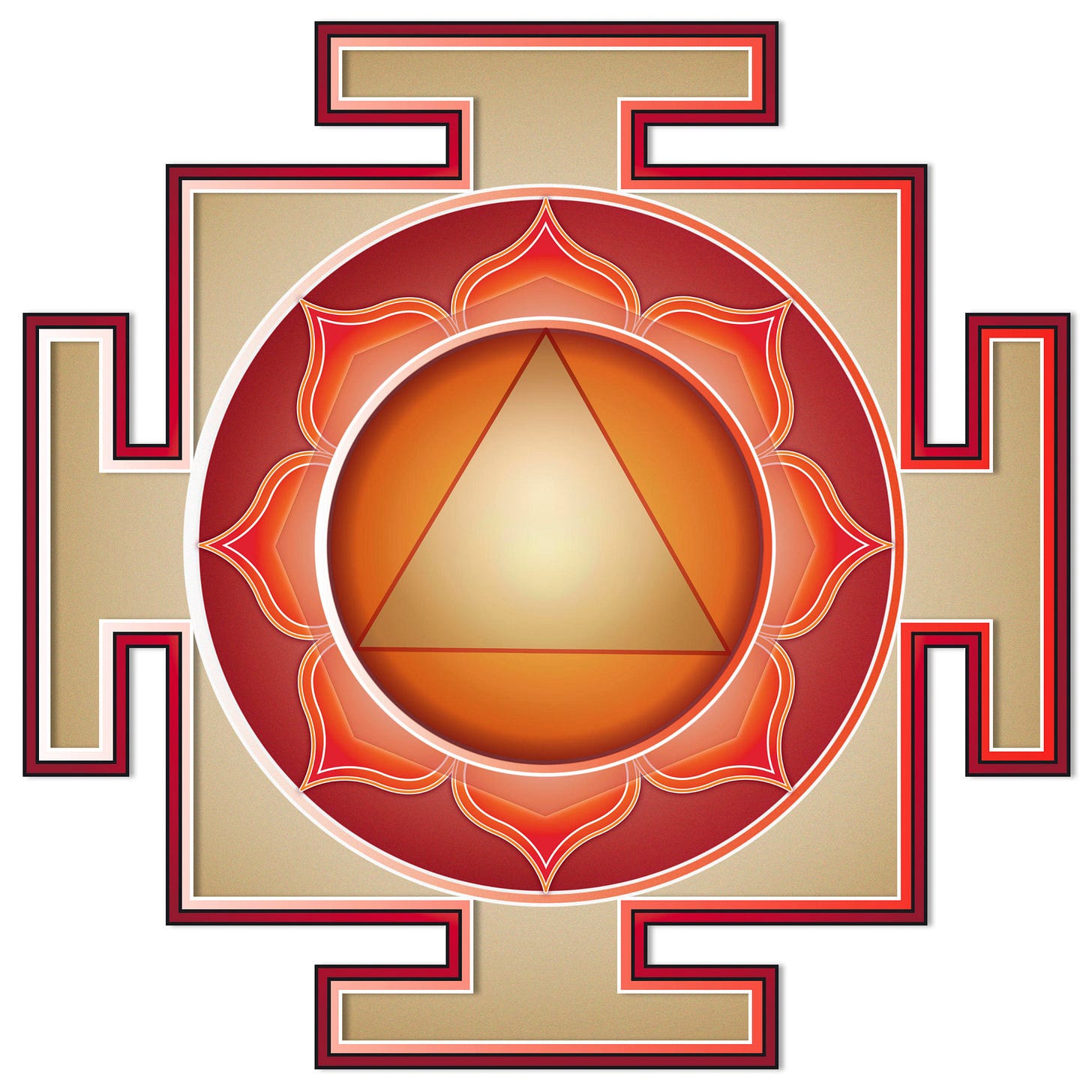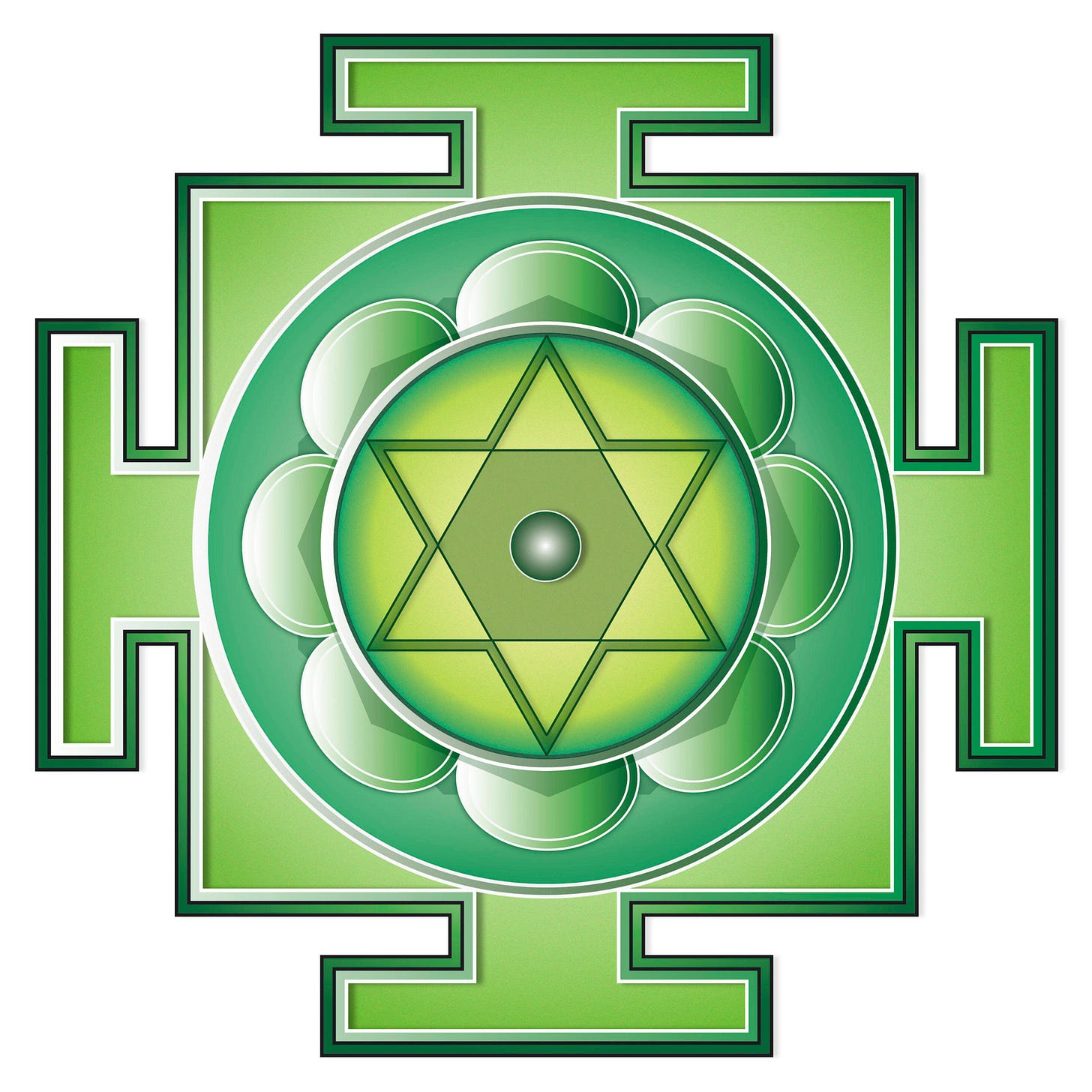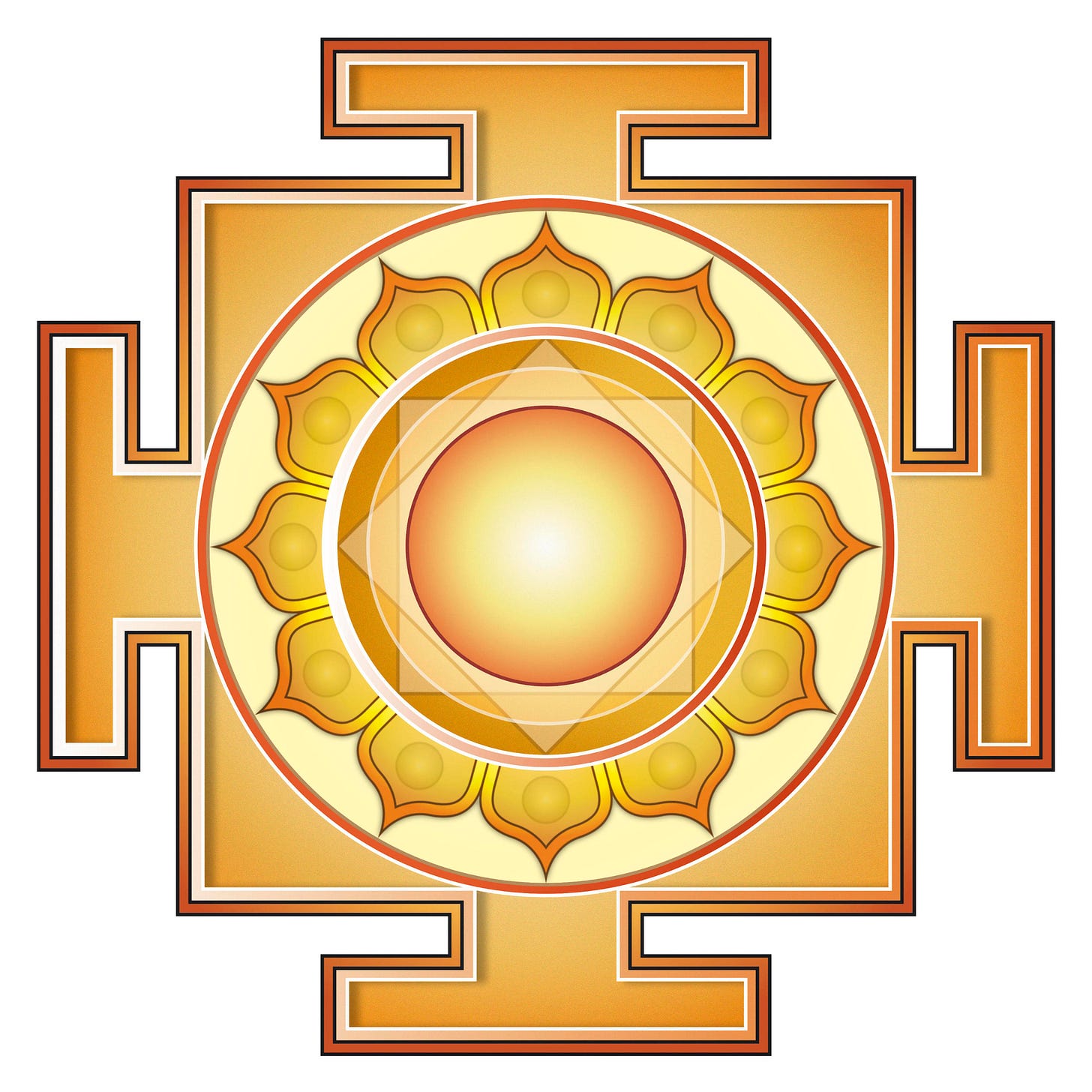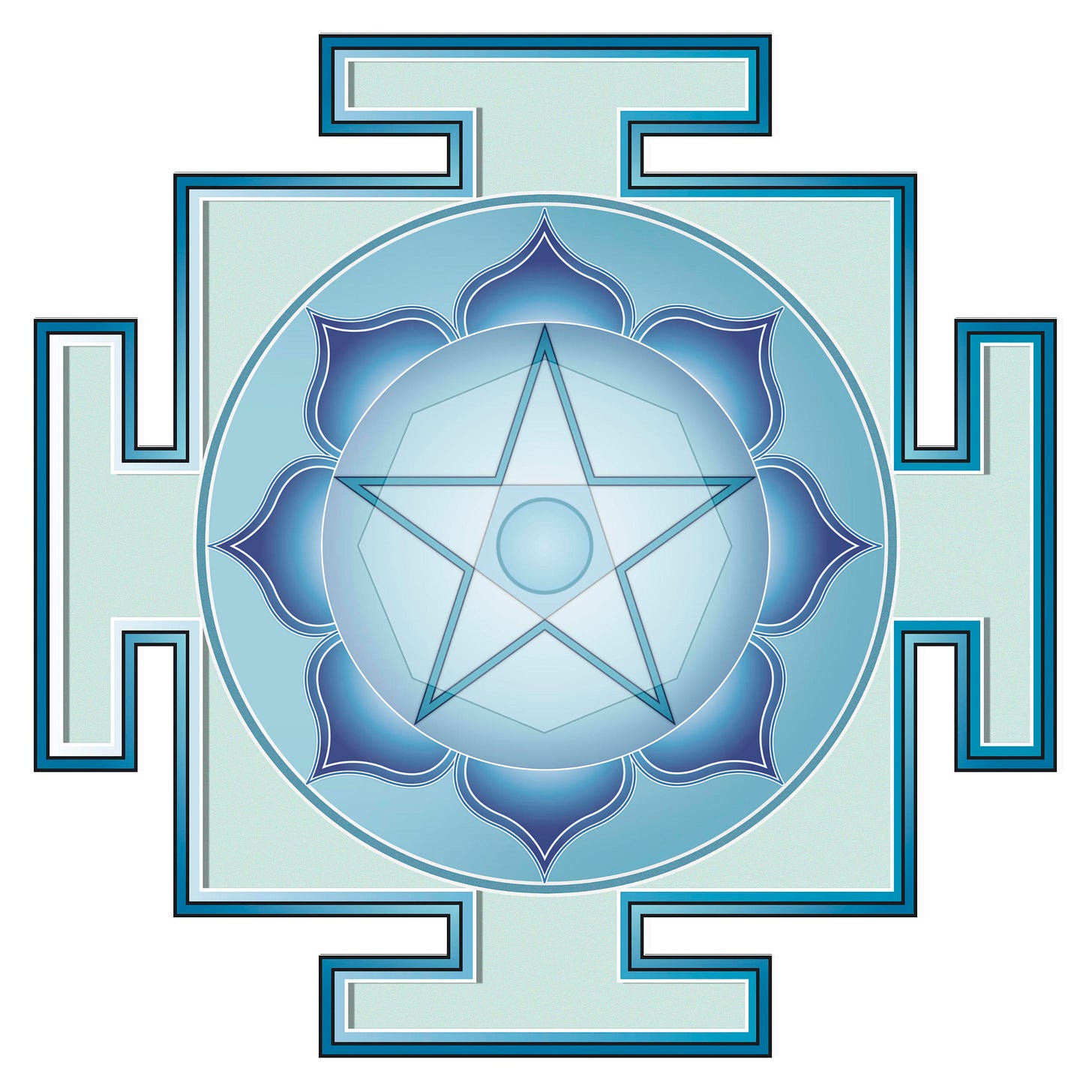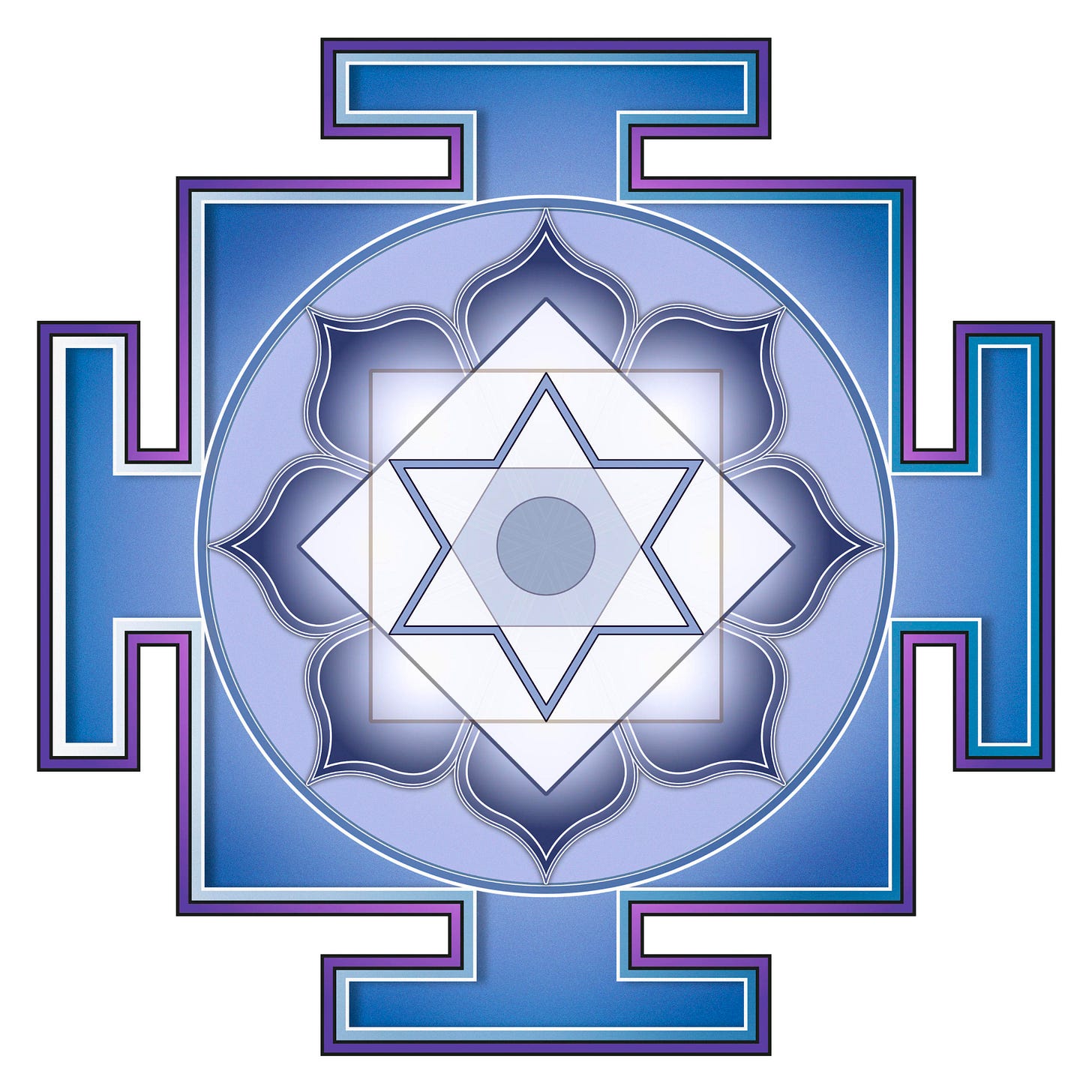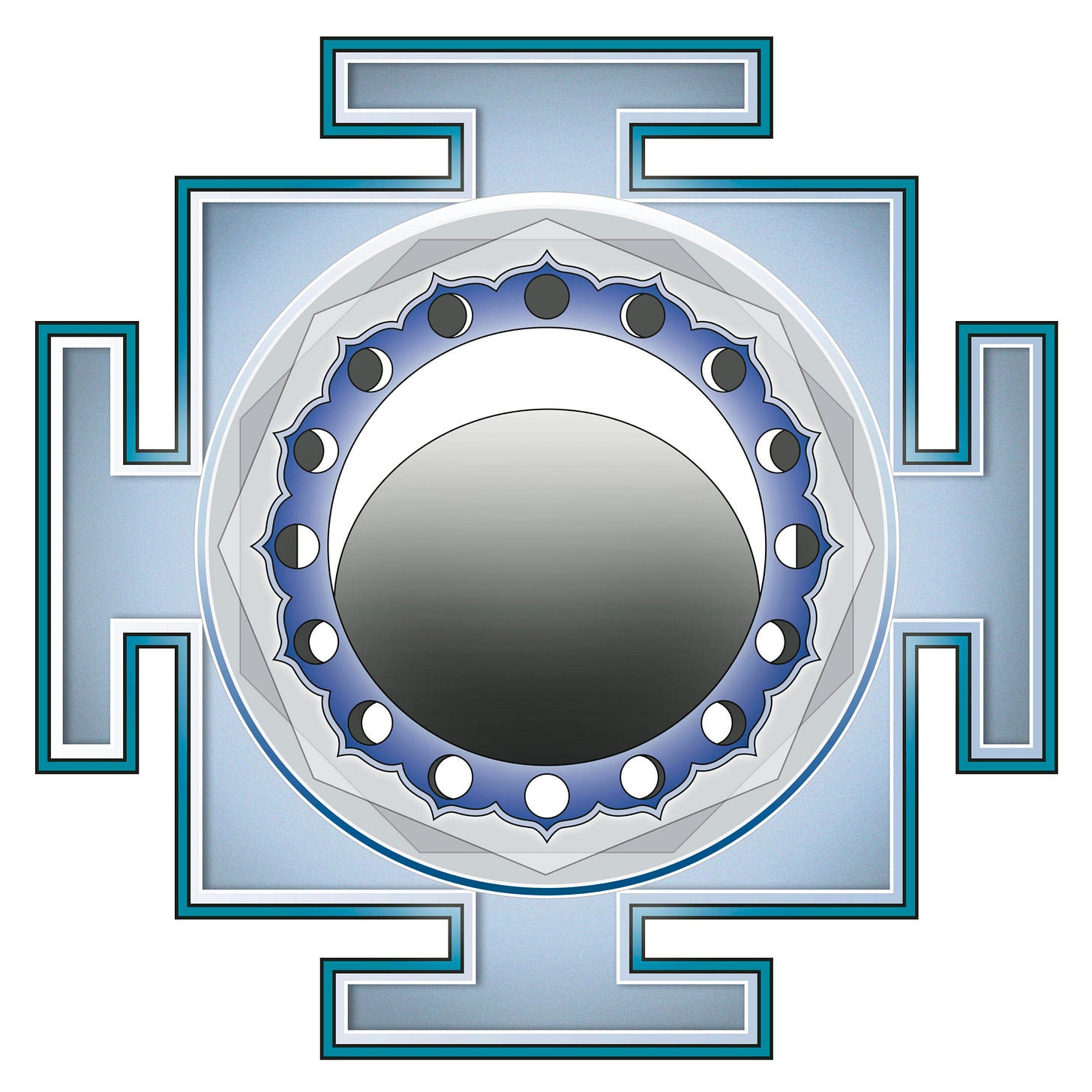The nine planets used in Jyotish
A brief introduction to Jyotish (Vedic Astrology)
In this two part article I concentrate on certain astrological influences within Ayurveda, more specifically examining correlations between planets (known as Grahas) and certain medicinal plants.
Interactions between astrology and medicine appear in many of the world’s ancient healing systems. The daily motion of the planets and light from the distant stars were all deemed to have an essential impact upon health as well as destiny. The attributes of all worldly substances be it animal, vegetable or mineral were likened to or fell directly under the auspices of a particular planet. This mutuality could be based upon physical appearance or be the result of long observed curative action. Needless to say, some plant materials were noted to propitiate as well as counteract the effects of negative planets. Over time, their inclusion in formulae, fulfilled two functions, firstly to aid in overall potency while secondly, the planets signature was being honoured by its inclusion.
In addition, Ayurveda readily intermingled the alchemical arts, known as Rasa Shastra along with Jyotish (Vedic astrology) and Hāsta Rekha Shāstra (Vedic palmistry). These are routinely included either potentise remedies, or included as diagnostic tools. During the manufacturing process of drugs, some texts will advise they be either harvested or prepared under certain lunar phases or that that the moon be located within a specific constellation, associated with that remedy.
Jyotish: is sometimes translated as science of starlight but in reality, this practice includes a number of important sub-disciplines. Traditionally all were essential for the successful practice of Astrology. These sub-disciplines were:
Polar longitude
Astronomy – an understanding of skies and the motion of heavenly bodies. Mapping daily planetary motion in relation to the signs of the zodiac was an essential part of astronomy and astrology.
Mathematical calculation – having observed the motion of planets detailed tables were consulted and compiled to allowed an astrologer to calculate the positions of heavenly bodies in the present, past and future. As it was not always possible to see planets and stars, it was essential to know where these bodies were, should the weather interfered with observation.
Birth horoscopy: is what most of us would equate with astrology. This is the construction and interpretation of a horoscope draw up from the birth time. Jataka relate to the specific Karmas impressed upon the individual at the time of birth.
Questioning: this method of astrology uses the current positioning of planets and stars to gain insight into a question being posed. So for instance, the astrologer might be asked, ‘is it was a good time to travel?’ After the question has been asked, a horoscope is constructed and an answer given, based upon the positions of the planets at the time of query.
Electional astrology: this practice seeks forthcoming astrological events to initiate ventures. This was done to maximise a successful outcome. Here astrological tables could be used to calculate future planetary positions and select an auspicious moment. Uses for Muhurta included, building a home, digging a well, journeying, trade and marriage.
Omenology: involves the study and interpretation of ‘signs’, these might include the cry of a peacock, the barking of dogs, the appearance of sunspots and comets or the sudden flaring of a flicker of ghee lamp. In some instances, Prasna would be based upon omenology, for instance, the direction an individual approached an astrologer, relative to the cardinal points and the Zodiac, could portent the outcome. A benefic sign rising in the direction from which the question came would indicate success and safe return.
Planets, signs and houses
Planets, Signs and Houses
In Sanskrit, the word Graha has multiple meanings, but generally means that which grasps or seizes. In the ancient world, a graha inferred unseen entities which sought to create mischief and havoc. In Vedic Astrology the The Grahas are the nine planets.
Traditionally, the nine planets were: The Sun, The Moon, Mars, Mercury, Jupiter, Venus, Saturn, Rāhu and Ketu. The latter two planets are the lunar nodes. They both mark points along the suns orbital path where the full or dark moon crosses the suns path. These are places were an eclipse periodically occurs. Collectively, the nine planets were known as Navagraha, or nine lords of karma.
The planets prompted awe and fear in the ancient world, their orbits (fast and slow) studied keenly as they passed through twelve idealised divisions of the sky. These divisions were known as Rashi, or the Zodiac, as we refer to them today. Each sign had its unique associations and energetics, adding richness to the heavens that made the skies more relatable to daily life. Today we call these twelve, Star Signs, constituting what most would understand as Astrology.
In addition to the twelve signs of the Zodiac, astrologers used a system of twelve Earth based Houses which interact with the Zodiac and produce a fusion of Zodiacal attributes that influence specific aspects of daily life such as: health, partnerships, wealth, happiness, career, death and losses. Each Zodiacal sign is ruled over by a planet, excluding the two lunar nodes. This powerful combination allows the individual sign to rise and fall in strength as its ruling planet itself transits through other Zodiacal signs. You might equate this to nine landlords, constantly moving home, sometimes residing in their own properties, or those owned by a friend. Sometimes they are forced to reside in a property owned by their enemy. It is this interaction between Planet, Sign and House that produces the myriad of possible daily outcomes. It is this interaction that also makes it possible to predict, due to the astrologers understanding of how each planet is likely to interact in a particular sign as well as with other planets in close proximity.
Planetary Yantra and their associated herbs
Herbs and Planets
Before looking at the herbs associated with each planet, we firstly consider the main characters of each planet. It is common to present their natural order to reflect the days of the week they rule. We begin with The Sun, and Sundays.
The Sun (Sūrya) - Sunday
The Sun indicates vital energy. When well positioned in the horoscope, He promotes strong healthy bones, teeth, a radiant complexion and sharp vision. His strength indicates the body’s ability to digest and assimilate. The Sun represents Agni (or digestive power) and is associated with the heart and small intestine. His positioning in the Zodiac reflects our stamina, courage and physical strength. When strong, The Sun supports the immune system and gives strength to the organs of assimilation. A strong Sun equals strong Agni, facilitating absorption and assimilation of nutrients. His fiery quality helps burn-up and expel toxins from the body. Generally, this planet considered a mild malefic, meaning he tends to cause harm; this is due to his hot and fiery nature, which dries up moisture, ageing the body prematurely.
The Moon (Chandra) - Monday
The Moon is considered soft, emotional and caring. When The Moon is well placed she gives clear thinking, emotional maturity, vital blood, a clear complexion and smooth skin. The Moon also rules the heart, but the emotional aspect of the heart. The stomach and blood are also controlled by The Moon. When The Moon is content, the mind and senses are balanced, if afflicted, The Moon causes much suffering to the mind and senses. Of all the planets, The Moon is the most affiliated with the herbal Arts; hence this planet is studied in great detail when selecting herbal remedies. Generally, The Moon is considered a mild benefic, meaning, overall it produces good effects. When full (or waxing) it gives its best results, when dark and waning, its results are diminished.
Mars (Kuja) - Tuesday
Mars is martial and warlike in manner. He represents physical prowess and raw-energy. As He rules muscular tissue, he promotes trim musculature, with a narrowing waistline, yet lacks height. If well placed in a horoscope, He gives tactical skill and a highly combative temperament. Mars is fierce planet, able to endure prolonged physical hardship; he is a fighter and a survivor. Mars floods the body with freshly oxygenated blood, creating heat, drive and passion. Being a hot planet He also helps burn-up toxins. The planet Mars pushes the body to its utmost limits, ultimately bringing fatigue and physical burnout. Generally, Mars is considered a highly malefic planet (grief producing). Some consider Mars to cause the most harm to the body.
Mercury (Budha) - Wednesday
Mercury inclines the individual toward quick thinking and sharp talking. This planet excels in trading, communication, sales and profiteering. Mercury holds the keys to many rooms, and can often gain entrance where others are barred. When strongly positioned the body is flexible, youthful and has good connections, ie: the tissues irrigate and interact with easy, from the electrical activity of neurons and synapses to the plasma content of blood. The planet Mercury is always tinkering/readjusting the suspension of the bodies mediums, this is why his influence slows ageing. Mercury also rules the skin and lungs, as well as reflex, speed and agility. More than any other planet, Mercury rules the nervous system. Traditionally, Mercury is called the healing planet as He presides over the physician within us. Being the child of The Moon, He also has access to the health arts and longevity practices. Mercury is considered a neutral planet, this means he has the ability to promote benefic and malefic effect. Because he is a highly impressionable planet, His association with other planets is paramount to his end effect. In close association with harm producing planets he acts as a malefic, in association with benefic planets, he gives health and longevity.
Jupiter (Brihaspati) - Thursday
Jupiter helps protect health and cushion life’s scrapes and knocks. This planet is considered the king of corpulence. Jupiter acts as the body’s store-house of fatty tissue. He also aids in the absorption and assimilation of nutrients (in the form of digestive enzymes), removing toxins through the liver and assimilating oils via bile secretions from the gallbladder. Although Jupiter partly contributes to pancreatic health, Venus is generally regarded as having the greater impact on the functionality of that organ. Jupiter’s is generally association with the rarefied element æther and as such, is also associated with the most subtle of bodily tissues. A well situated Jupiter helps lubricate the joints while adding cohesion via its essential lipids (including cholesterol). Jupiter is unctuous (slippery) by nature, He adds smoothness, resistance, flexibility and elasticity to the limbs. He improves brain functionality, particularly memory and brain capacity. He is the great teacher, wise and learned in scriptures. Jupiter is generally considered the most benefic planet, likely to aid much in a smooth transition through life.
Venus (Briguja) - Friday
Venus similarly aids in both the digestive process and the elimination of toxins via the water element ie: kidneys and bladder. Venus also supervises food refinement through the seven tissues which culminate in Ojas. This precious substance is essential to life and overall immunity. While the Moon also presides over water metabolism, Venus is mostly responsible for the maintenance of health via its moisturising secretions, elasticity, suppleness of skin, and youthfulness, hence both the Moon and Venus rule over physical beauty. Venus, also known as Shukra is representative of our vitality and reproductive fluid and physical potency (procreation). Venus, like Jupiter, is considered a highly benefic planet. When strong He promotes luxury, good living and beauty, but is also prone to overindulging.
Saturn (Shani) - Saturday
Saturn was understood to be the most distant planet, dark, cold and friendless in the skies. In the ancient world, He symbolically kept all planets in check. Deemed to be people unfriendly, He preferred solitude and abstinence. In matters of health, Saturn assisted in the erosion of bodily tissues via the ageing process. He principally manifests in the muscular-skeletal system, especially the joints. Saturn aids in the reabsorbing of liquids and the final elimination of solid waste from the colon. When Saturn concentrates himself in the body, he creates brittleness and dryness, his presence marked by dullness of the sclera (whites of the eyes). Signs of Saturn’s detriment in health are muscular atrophy and emaciation. He is identified with falling teeth, greying hair, weak hands, haemorrhoids and fistula. Persons under a strong saturnine influence often show a pronounced darkness rimmed about the eyes. Like Mars, Saturn is considered a highly malefic planet, capable of causing much harm and discomfort throughout life.
Rāhu (Northern Lunar Node) - Saturday
Neither Rāhu nor Ketu have a physical existence. You cannot point to them or glimpse them through a telescope; however, you can witness their effect. They act upon other planets, particularly when they draw close to them. They do have some specific qualities, these are:
Rāhu rules over psychotic episodes, strong desires and cravings, deranged thinking and a hunger for power. He is conspiratorial, frequently drawn to the darker ‘addictive’ aspects of life. He rules intoxicating substances, hallucinations and poisoning. In matters of health, Rāhu creates all manner of imbalances, causing deficiency as well as excesses in the body. Rāhu leaps between tissues, constantly relocating in the body and confounding diagnosis. Rāhu is more often than not a causative factor in spreading diseases, or those diseases requiring strong medicines to stem their advance. Overall, Rāhu is said to act and look much like Saturn.
Ketu (Southern Lunar Node) - Tuesday
Ketu signifies discord, global calamities and mass destruction. His condition in one’s horoscope is assessed to judge the likelihood of an individual being affected by such catastrophes. Ketu is associated with mass psychosis, psychic and metaphysical attack, as well as paranormal apparitions such as ghosts, phantoms and other disincarnate spirits. In health, Ketu rarefies bodily tissues, creating a loss of structural integrity or mal-absorption. These deficiencies often accrue over time, avoiding detection through stealth. Ketu-type diseases manifest slowly with a noted decline in physical strength. His handiwork may also confuse attempts to render a diagnosis. Ketu-related health issues are more than likely to abate quickly yet reoccur in longer periods, relocating from their initial site of injury, leaving behind a tell-tale colourful bruise. Overall, Ketu is said to act and look much like Mars.
END OF PART.1


